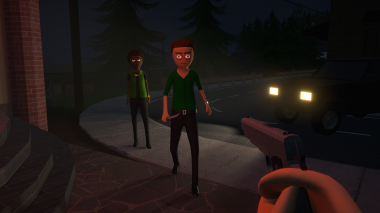
Schedule I Review
My Unexpected Journey into Schedule I Game
I embarked on the Schedule I Game with a blend of excitement and curiosity. My initial encounter was filled with anticipation; I had heard whispers on gaming forums about its unconventional approach to storytelling and gameplay mechanics. This game presented an opportunity to immerse myself in a narrative that felt both unorthodox and refreshingly daring, pulling me into its unique world right from the first moment.
Exploring the Narrative Depths
The narrative structure in Schedule I Game was one of the first aspects that drew me into its labyrinthine plots. Unlike many contemporary games that rely on linear storytelling, this game scattered clues across its expansive digital domain, inviting me to piece together its enigmatic background. The dialogue was meticulously crafted, and the characters, each with their own intricacies, felt deeply developed. I often found myself pausing the gameplay to reflect on their decisions and the implications they held for the unfolding narrative. As I progressed, the depth of the story became a personal journey into understanding human motivations, societal enigmas, and the interplay between fate and choice.
Innovative Gameplay Mechanics
Once immersed in the narrative, the gameplay mechanics unveiled themselves in layers of challenge and innovation. Schedule I Game offers a hybrid experience that merges strategy and action in unexpected ways. I enjoyed the moment-to-moment decisions that were critical in shaping the outcome of encounters and puzzles alike. Every level required me to adapt to unique conditions, ensuring that no two gameplay experiences were entirely identical. The mix of exploration, problem-solving, and dynamic in-game interactions kept the adrenaline running high while also making room for reflective pauses when needed. It wasn’t just about advancing from one level to another; it was about savoring the intricacies of each challenge as an opportunity for a deeper dive into the game’s mechanics.
Interactive World and Dynamic Environments
The game world is a sprawling expanse of intricate detail and evolving landscapes. What struck me most was the interconnectedness of various regions and locations within Schedule I Game. Every time I traversed from one area to another, I encountered environmental puzzles and unusual phenomena that compelled my attention. The dynamic environments were not merely backdrops; they acted as active participants in the unfolding story. Whether it was the eerie silence of nocturnal settings or the vibrant clash of urban chaos, the game demanded that I pay attention to both the macro and micro details. This immersion into an interactive world redefined my expectations from virtual settings and made every exploration feel like a personal quest full of discovery.
Visual Aesthetics and Artistic Vision
The artistic direction of Schedule I Game is both bold and unconventional. The designers have taken significant creative risks, blending surrealist elements with traditional gaming styles to create an aesthetic that stands apart. Every cutscene and in-game artwork is a testament to the creators’ dedication to storytelling through visuals. I vividly remember moments when the interplay of light and shadow, combined with an almost poetic use of color, transformed routine scenes into breathtaking spectacles. The textures and details of the digital landscapes, characters, and even small environmental cues have been rendered with such care that each pixel seemed to contribute to the overall narrative. This marriage of high art and digital craftsmanship continually engaged my senses and enriched my experience at every turn.
Soundscapes and Audio Integration
The auditory experience in this game is nothing short of mesmerizing. The carefully curated soundscapes work in tandem with the visuals to elevate the emotional stakes of every encounter. From the soft hum of ambient electronic tunes to the crescendo accompanying dramatic plot twists, the sound design is integral to the game’s immersive experience. I particularly appreciated moments when subtle background music indicated the unfolding of certain in-game events, which made even ordinary tasks feel imbued with a sense of purpose. The sound effects were equally well executed, providing feedback on my actions in a way that not only informed me but also deepened my connection to the world. Every auditory nuance resonated with the overarching themes of mystery and unpredictability.
Engaging Puzzles and Strategic Challenges
One of the most stimulating aspects of Schedule I Game was its approach to puzzles and strategic encounters. I found that the challenges in this game did not rely on repetitive tasks but instead required genuine thought and experimentation. Each puzzle was a mini-challenge, demanding that I adopt unconventional viewpoints and piece together abstract clues. What I appreciated most was the balance between difficulty and accessibility; whereas some puzzles proved decisively complex, they were designed to be surmountable with persistence, attention to detail, and creative thinking. In many instances, the puzzles felt like dialogues with the game itself, encouraging a deeper engagement with the narrative and forcing me to unlock hidden secrets that lay beneath the surface.
Dynamic Character Interactions and Emotional Engagement
The characters in Schedule I Game are far from mere NPCs; they carry personal stories that unfold alongside the primary narrative. One of my favorite moments was spending time in dialogue with a reclusive character who gradually revealed layers of a haunting personal past. The emotional depth infused into these interactions made every conversation feel laden with significance. The way the game allows for multiple branches in dialogue choices further contributed to this richness, providing an opportunity to shape the intricacies of personal relationships. I found that, as the narrative progressed, even seemingly insignificant characters might pivot the storyline in unexpected and emotionally charged directions. This focus on dynamic character interactions turned each play session into a highly personalized narrative experience.
Technical Performance and Optimized Functionality
From a technical standpoint, I was pleasantly surprised by the smooth functionality of Schedule I Game. Despite its intricate graphics and multifaceted gameplay, the performance was consistently stable. Load times were kept to a minimum, and even in the most visually demanding scenes, there was a remarkable balance between detail and performance. I noted that the game’s engine was optimized to handle various scenarios without compromising frame rates, which is no small feat given the visual and interactive complexity present in many sections. The responsiveness of controls further enhanced the gameplay experience by ensuring that every input was registered swiftly, thus preserving the immersive quality of high-tension moments. Technical mastery, in my view, has played an essential role in creating a seamless and rewarding play experience.
Customization and Player Agency
A noteworthy element of Schedule I Game is the level of customization it affords. I was impressed by how the game allowed me to tailor my in-game experience to suit my own style of play. From character appearance to the specifics of skill advancement, the options were both broad and meaningful. The ability to tweak settings and streamline the interface played a crucial role in enhancing my overall interaction with the game. I felt truly empowered when decisions regarding loadout, skill progression, or even in-game visual filters could be made to reflect personal tastes, thus intensifying the sense of ownership over my virtual journey. This emphasis on player agency felt revolutionary, making every decision a deliberate extension of my individual play style.
Multiplayer and Community Engagement
While Schedule I Game is primarily an exploration of a richly woven single-player narrative, it also offers avenues for engaging with other players in meaningful ways. I discovered that online forums and in-game community events provided an additional layer of interaction that enriched the overall experience. The game includes cooperative challenges where players must work together to overcome particularly difficult scenarios. I relished the moments when I collaborated with fellow enthusiasts, sharing insights and strategies that illuminated aspects of the game that I might have otherwise overlooked. This interplay between solitary narrative exploration and community dynamics allowed for a broader exchange of ideas and shared experiences, making the game feel like an evolving conversation among dedicated fans.
Immersive Worldbuilding and Lore
The lore embedded in Schedule I Game is intricate, weaving a tapestry of history, culture, and philosophy that beckons players to dive deeper and uncover hidden references. I spent countless hours poring over in-game artifacts, deciphering ancient scripts, and interpreting lore-rich environments. The worldbuilding is a soft yet persistent whisper that grows louder with each discovery. It encouraged me to think beyond the surface-level narrative and appreciate a broader context that connected disparate elements in fascinating ways. These haunting legends and cryptic prophecies gradually coalesced into a universe that was as expansive as it was enigmatic. The journey of uncovering the lore felt like piecing together fragments of a forgotten dream, a process that was both intellectually stimulating and emotionally engaging.
Unpredictable Plot Twists and Emotional Resonance
Schedule I Game is replete with unexpected plot twists that kept me on my toes at every juncture. I found that the story rarely took a predictable route; instead, it meandered through unexpected territories that constantly redefined my understanding of the narrative’s direction. This unpredictability was both challenging and highly rewarding. I often felt a surge of adrenaline when familiar elements suddenly transformed into new plot directions. The surprises were not merely shock moments; they were carefully constructed events meant to deepen the central themes of ambiguity and fate. For me, the emotional resonance of these twists was profound. Each revelation was accompanied by an internal reflection on the nature of destiny and the impact of personal choices, making every shift in the story’s trajectory a personal and introspective milestone.
Experimental Controls and Interface Design
Another aspect that captivated me was the experimental approach taken in the design of controls and interface. Schedule I Game avoids the one-size-fits-all model that is common in many titles, instead opting for an interface that evolves with the player’s progression. Early on, I was introduced to a minimalist layout that gradually incorporated advanced features as I became more acquainted with the world. This gradual unveiling prevented me from feeling overwhelmed while still rewarding exploration and curiosity. The customization options for controls allowed me to match the interface with my own reflexes and comfort, which in turn fostered a more intuitive and satisfying gaming experience. Every time I adjusted the layout to my liking, I felt a renewed connection with the digital realm that the game so meticulously creates.
Interaction with In-Game Technology and Mechanics
What makes Schedule I Game stand out from many other titles is its innovative approach to integrating in-game technology with storytelling. I was particularly drawn to the fact that technology in this universe was not just a backdrop but an interactive participant that influenced both gameplay and narrative development. Digital devices, virtual interfaces, and holographic displays within the game world carried a futuristic aesthetic that felt both familiar and entirely novel. The control systems that governed these technologies were built to be both accessible and challenging, urging me to use them as tools in deciphering the puzzle of the game’s broader mysteries. This seamless integration of technology into the fabric of storytelling made every interaction a multidimensional experience, fusing abstract technological concepts with heartfelt narrative moments.
Exploration of Philosophical Themes
The Schedule I Game is more than a journey through a digitized tale; it is a thought experiment that poses profound questions about existence, control, and destiny. I found myself musing over philosophical queries long after each gaming session ended. The game frequently presented moral dilemmas, ambiguous forces of fate, and the consequences of free will. These challenges provoked internal debates about the nature of responsibility and the boundaries between predestined events and personal choices. It provided a canvas for me to explore my own beliefs and challenge the conventional narratives that often go unexamined in mainstream entertainment. Engaging with these themes allowed me to appreciate the game not only as an intricate puzzle but also as a reflection on the human condition through a digital medium.
Hidden Gems and Subtle Easter Eggs
Throughout my journey with Schedule I Game, I was continually surprised by hidden gems scattered across its expansive world. The developers have seeded numerous subtle details and secret references that reward exploration and keen observation. I spent many hours retracing my steps in search of these elusive elements. Every time I uncovered an Easter egg, it brought with it a fresh burst of excitement, as if I had discovered an intimate secret shared only among true fans of the game. These moments were not merely about collecting achievements; they deepened my overall experience by providing additional context and layers to the story. The thrill of finding a new secret detail not only enhanced the narrative but also contributed to a greater appreciation of the game’s meticulous design and attention to detail.



